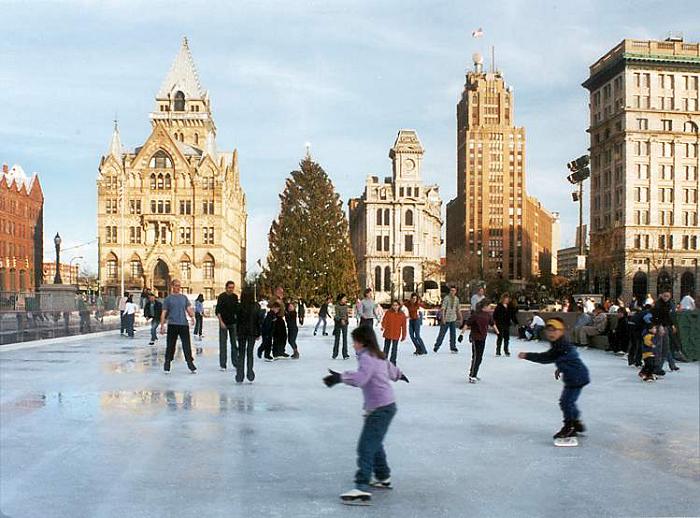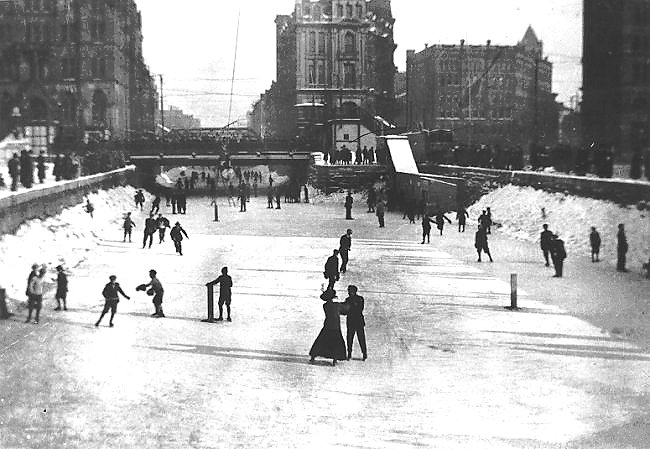Clinton Square - The Future |
How will the New Clinton Square Function as a Public Space?The Project for Public Spaces (PPS) is a non-profit organization specializing in the "planning, design and management of the public realm." Founded in 1975, it has evaluated over 1,000 public spaces around the world. As a result of their research, PPS has identified four qualities that are critical for any public space:
Below are some questions PPS suggests you can ask when evaluating a public space. As you read them, think about our local public spaces -- particularly Clinton Square and Hanover Square.
Photo: Preservation Association of Central New York |
|
Access & Linkages: You can judge the accessibility of a place by its connections to its surroundings, both visual and physical. A successful public space is easy to get to and get through; it is visible both from a distance and up close. The edges of a space are important as well: For instance, a row of shops along a street is more interesting and generally safer to walk by than a blank wall or empty lot. Accessible spaces have a high parking turnover and, ideally, are convenient to public transit. Can you see the space from a distance? Can you see into its interior from the outside? Is there a good connection between the space and the adjacent buildings, or is it surrounded by blank walls? Do occupants of adjacent buildings use the space? Can people easily walk to the place? For example, do they have to dart between moving cars to get there? Do sidewalks lead to and from the adjacent areas? Does the space function for people with special needs? Are there roads and paths through the space and do they take people where they actually want to go? Can people use a variety of transportation options -- bus train, car, bicycle, etc. -- to reach the place? Are transit stops conveniently located next to destinations such as libraries, post offices, park entrances, etc.? Comfort & Image Whether a space is comfortable and presents itself well - has a good image - is key to its success. Comfort includes perceptions about safety, cleanliness, and the availability of places to sit -- the importance of giving people a choice of where to sit is generally underestimated. Women in particular are good judges of comfort and image and tend to be more discriminating about the public spaces they use. Questions to consider regarding Comfort & Image: Does the place make a good first impression? Are there as many women as men? Are there enough places to sit? Are seats conveniently located? Do people have a choice of places to sit, either in the sun or shade? Are spaces clean and free of litter? Who is responsible for maintenance? What do they do? When? Does the area feel safe? Is there a security presence? If so, what do these people do? When are they on duty? Are people taking pictures? Are there many photo opportunities available? Do vehicles dominate the space, or prevent pedestrians from easily getting to the space? Uses & Activities Principles to keep in mind in evaluating the uses and activities of a place: The more activities going on, and that people have an opportunity to participate in, the better. There should be a good balance between men and women (women are more particular about the spaces that they use). People of different ages should use the space (retired people and people with young children can use a space during the day when others are working). The space should be used throughout the day. A space that is used by both singles and people in groups is better than one that is used just by single people -- it means that there are places for people to sit with friends, there is more socializing, and it is more fun. The ultimate success of a space is determined by how well it is managed. Questions to consider about Uses & Activities: Are people using the space or is it empty? Is it used by people of different ages? Are people in groups or alone? How many different types of activities are occurring -- people walking, eating, playing baseball, chess, relaxing, reading? Which parts of the space are used and which are not? Are there choices of things to do? Is there a management presence, can you identify that anyone is in charge of the space? Sociability This is a difficult quality for a place to achieve, but once attained it becomes an unmistakable feature. When people see friends, meet and greet their neighbors, and feel comfortable interacting with strangers, they tend to feel a stronger sense of place or attachment to their community - and to the place that fosters these types of social activities. Questions to consider about Sociability: Is this a place where you would choose to meet your friends? Are others meeting friends here or running into them? Are people in groups? Are they talking with one another? Do people seem to know each other by face or by name? Do people bring their friends and relatives to see the place or do they point to one of its features with pride? Are people smiling? Do people make eye contact with each other? Do people use the place regularly and by choice? Is there a mix of ages and ethnic groups that generally reflects the community at large? Do people tend to pick up litter when they see it? (The information here comes from What Makes a Successful Place? at
PPS's website. If you'd like to read more, go here:
http://urbanparks.pps.org/topics/gps/gr_place_feat). The Verdict
Photo courtesy of Syracuse Blueprint
"My foundation-supported group, the Street Life Project, was set up to learn how city spaces are used. One of the first findings was that the 'overcrowded city' is a myth. Most of the spaces observed were not overused: They were underused. Conversely, the spaces that people most enjoyed and found most restful were the most intensely used. The street is a surprisingly sociable place, and high density is a condition of its vitality. A successful street has a critical mass of activity and of people. Pedestrian malls that have failed have done so in part because they diffused people and activities over too expansive a space. "Successful spaces are not cut off from the street; they are not elevated high above it, nor are they sunk down beneath it. Sunken plazas are usually empty. "The elements of a good city space, then, are basics, and it is interesting to note how many of them are natural -- people to watch, sun to bask in, trees to sit under, water to splash in and listen to. Nowhere does nature seem so important to people as in the city, and enjoyment of the city outdoors is increasing. "Small, winding streets are a treasure. Among other things, they slow down cars enough to let pedestrians bully them to a dead stop. The grid system has advantages, too. In most cases, the blocks are small enough to establish a repetitive pattern of cross streets that interrupts what might otherwise be single projects of immense size. It is significant that the most successful large complex in the U.S. did not eliminate streets but actually added some. This, of course, is Rockefeller Center. "...The city is losing the function for which it is no longer suited -- manufacturing -- but reaffirming its great and most basic function as a place for people to come together. This is the street: busy, noisy, crowded, tacky, but full of life and vitality. And full of continuity -- the sense of where we are and where we've come from. There's our future." William H. Whyte, in "The Humble Street." Historic Preservation. January, 1980. pp. 34-41. |

